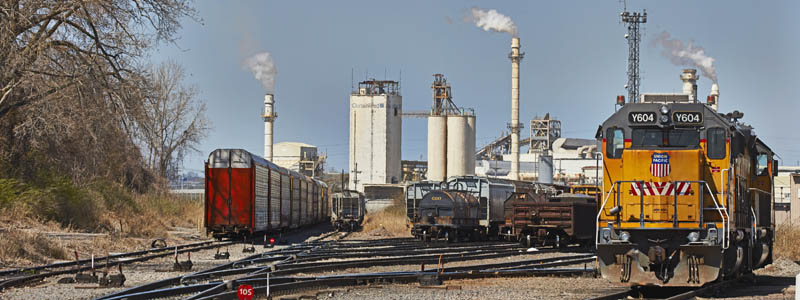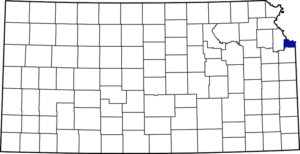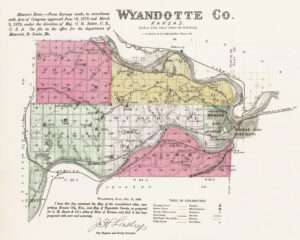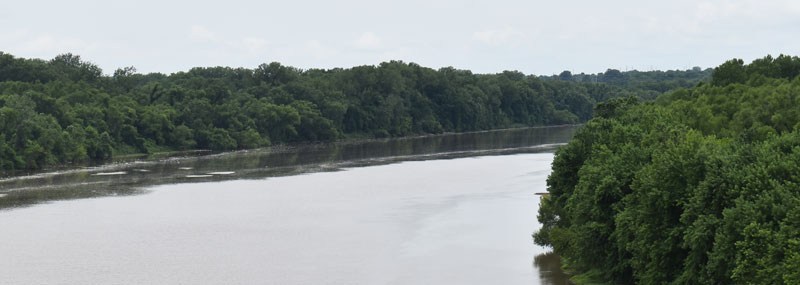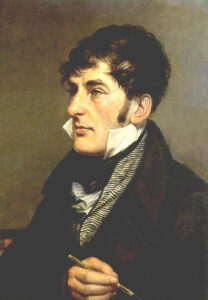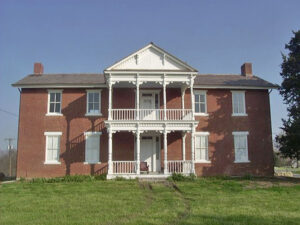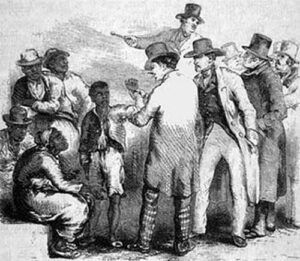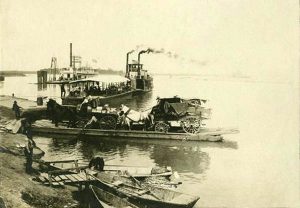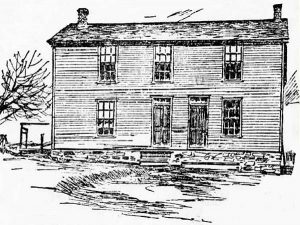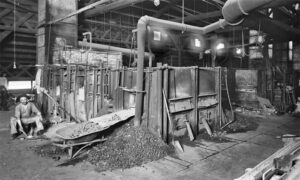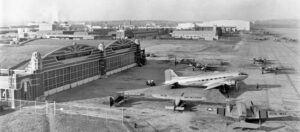Towns & Places
Bonner Springs (partly in Leavenworth and Johnson Counties)
Edwardsville
Kansas City – County Seat
Lake Quivira (partly in Johnson County)
Kaw Point Park
Wyandotte County Lake & Park
Wyandotte County Photo Gallery
Wyandotte County, Kansas, is located in the extreme eastern part of the state. Its county seat and most populous city is Kansas City.
It was formed from the southeastern part of Leavenworth County by an act of the legislature on January 29, 1859. It is the smallest county in the state, having an area of only 153 square miles.
Triangular in shape, it is bounded on the north by Leavenworth County and the Missouri River, east by the Missouri River, south by Johnson County, and west by Leavenworth County. It was named for the Wyandot Indians.
The general surface of the country is undulating, marked by high bluffs along the Kansas and Missouri Rivers. In the early territorial days, the county’s eastern portion was heavily wooded with cottonwood, hickory, oak, walnut, and other native Kansas tree varieties. The main watercourse is the Missouri River. The following stream of importance is the Kansas River, which forms a part of the southern boundary, flows northeast, and empties into the Missouri River at Kansas City. Springs were found in all portions of the county.
Limestone, sandstone, fire clay, and cement rock were in considerable quantities. Coal was reached at a depth of 300 feet and was mined for commercial purposes. The soil is a rich, sandy loam, especially well-suited for fruit raising. Agriculturally, the county ranked high, with winter wheat, corn, and oats being important crops. It was also the “banner” county in potato production. Over 300,000 fruit trees of bearing age existed, with apple and peach being the leading varieties.
The portion of Wyandotte County lying south of the Kansas River, except for a tract reserved by the government, once belonged to the Shawnee Indians.
It is not known for sure in which year the first white men visited this part of Kansas, but it was early in the 18th century when the French explored the lower part of the Missouri River, as far as the mouth of the Kansas River. A few years later, at least 100 independent French-Canadian traders worked with the Indians along the Missouri River. In 1703, Charles Le Sueur was sent to the headwaters of the Mississippi River on a mining expedition. On his return in 1705, he traveled up the Missouri River as far as the mouth of the Kansas River. Lewis and Clark passed along the eastern boundary of the present county and camped at Kaw Point in 1804 during their government-sponsored exploration expedition. They discovered several old Kansas villages, including an ancient village site a little east of White Church.
So far as is known, the first white men who permanently established themselves in the county were the Chouteau brothers, Indian traders who built their first trading post in 1812. Cyprian Chouteau subsequently built several other trading posts north of the Kansas River, the most important of which was the famous “Four Houses.”
A Methodist mission among the Delaware Indians was founded in 1831, and a Baptist mission followed the year after. The first church in the county was erected as a mission in 1832 in a beautiful grove located on the high divide, where the town of White Church stood, near the county’s center, about eight miles west of Kansas City. The missionaries in charge of the churches and schools were the second whites to settle permanently.
In about 1831, Moses Grinter, one of the area’s earliest permanent white settlers, set up the Grinter Ferry on the Kansas River at the Delaware Crossing. This military crossing, sometimes called “the Secondine,” was where an old Indian trail met the Kansas River. The ferry was used by traders, freighters, and soldiers traveling between Fort Leavenworth and Fort Scott on the military road. Others crossed this area on their way to Santa Fe, New Mexico. His house was known as the Grinter Place, where he operated a trading post. He also operated the first non-military post office in Kansas. The building remains and is listed on the National Register of Historic Places.
When the Wyandot Indians came to Kansas from Ohio in 1843, they were civilized. The farms they opened, the homes they built, and the schools and churches they established were as good as, or better than, similar institutions among the whites of the frontier and, in many cases, better.
The city of Wyandotte, later known as Kansas City, Kansas, was established by the Wyandot Indians soon after they were relocated to the reservation, with the construction of a company store and a cabin for the United States agency. Within two years, the settlement had become a flourishing frontier town. On July 1, 1844, the first free school in Kansas was opened in Wyandotte by J. W. Armstrong. The first school building was a frame structure located on what would later become Fourth Street, also known as the council house.
The conflict between the pro-slavery and Free State advocates began to rage in the Wyandot Nation six years before it became a vital question in the territory. In 1843, their Methodist missionary preached against the emancipation of slaves. Four years later, it began organizing a “Church South” among them, a church supported by the most pronounced pro-slavery men. Most of the nation refused to join this church when it was organized, and when the church rejected the minister appointed from the Northern Conference, he held services outdoors until another church was built. The hostility between the two church branches continued to be that of the opposing political parties until it reached its height in 1848. As a result, drunkenness and disorder increased among the members of the tribe. This led to a temperance society, the first in Kansas, and a log jail was built at Wyandotte, where drunken Indians were confined.
When the California Gold Rush began in 1849, the Wyandotte and Chouteau trading posts became the outfitting posts for many parties heading west. Thousands passed through the county, but few settled there, lured west by the call of gold. Many Mormons also passed through the county.
The first agitation occurred among the Wyandot as they looked toward a territorial organization. They set up a constitutional form of government, like the one in Ohio, and elected their territorial governor.
After establishing the territory, Wyandotte County’s first accomplishment was surveying and grading good roads. The first was laid out from Quindaro to Lawrence, a valuable highway because it connected two of the most important free-state settlements. It was in good condition as early as 1857. Ferries across the Missouri River were established at Quindaro and Wyandotte that year. The first bridge in the county was built in 1858, about three miles above Wyandotte. The funds for it were obtained through private subscription. In 1859, the legislature established a territorial highway from Wyandotte to Elwood in Doniphan County, running through Quindaro, Leavenworth, and Atchison.
The political history of Wyandotte County began with the first election, held in June 1857, for a delegate to the Lecompton Constitutional Convention. In October of that year, the region came into general notice due to ballot box stuffing and other fraud during the election held at Delaware Crossing, eight miles west of Wyandotte.
The pioneer Episcopal parish of the territory — St. Paul’s — was established at Wyandotte in 1857. The following year, the Congregational church and St. Mary’s Catholic parish were established.
By the act of creating the county in 1859, Wyandotte was named as the temporary county seat. The county was organized on February 25, when the county commissioners, George Russell and George Veale, first met. They appointed Myron J. Pratt secretary, canvassed the votes cast at the election of February 22, and issued certificates of election to Jacques W. Johnson, probate judge; Samuel E. Forsythe, sheriff; Marshall A. Garrett, clerk of the board of supervisors; Vincent L. Lane, register of deeds; Robert Robetaille, treasurer; William L. McMath, county attorney; Jacob B. Welborn, county superintendent; Cyrus L. Gordon, surveyor, and George B. Wood, coroner.
Rooms in business buildings were rented for the county offices until they were established in the building known as Constitution Hall. From there, they were moved to a building on Minnesota Avenue but were changed several times before being established in the brick courthouse completed in 1882 for $35,000.
Although a border county where pro-slavery and free-state men strove for control, Wyandotte never took a conspicuous part in politics. Yet, in this county, one of the most important political events in the territory’s history occurred when, on July 5, 1859, the Wyandotte Constitutional Convention was held and framed the constitution under which Kansas was admitted to the Union.
As early as 1857, the people of Quindaro began agitation for a railroad to connect that town with St. Joseph, Missouri. The first actual grading for a railroad was done at Wyandotte on the Kansas Valley line in 1859.
At the outbreak of the Civil War, meetings were held at various points in the county, and several companies were rapidly recruited. Among them were the Kansas Mounted Riflemen from Quindaro and Wyandotte, representing the county in many Kansas regiments. During the years of warfare, the county’s residents suffered from the raids of organized bands of guerrillas who ran off cattle and horses. Jayhawking on the part of both sides raged through the country, and unoffending citizens suffered. The end of the war did not bring an end to these conditions in Wyandotte County. Murders and lynchings went on for two years before the passions aroused by the terrible conflict died away, and peace again reigned along the border.
In 1863, the Kansas Pacific Railroad was put into operation through the county along the north bank of the Kansas River. In 1866, the Missouri Pacific Railroad was built through the eastern and northeastern parts of the county.
The state legislature located the state school for blind students in Wyandotte County, the first building erected in 1867, in the northwest part of Wyandotte. The medical department of the University of Kansas was located at Rosedale. The Kansas City University, the Kansas City Theological Seminary, and eight Roman Catholic institutions were also located in Kansas City. Western University, a state industrial school for African Americans, was located at Quindaro.
In the 1880s, the Kansas City Smelting and Refining Company employed over 250 men. The ore and base bullion were received from the mountain mining districts and were crushed, separated, and refined.
The population of the county in 1910 was 100,068.
In 1936, construction began on the 400-acre Wyandotte County Lake, which continues to serve the public with 1,500 acres of wooded area and recreational opportunities.
In 1941, the production of B-25 bombs began at Fairfax Field, north of Kansas. The Fairfax facility became the country’s biggest producer of B-25 medium bombers, and by the fall of 1942, women held 27% of the plant’s jobs. During World War II, approximately 40% of the workforce consisted of women. When the war ended in 1945, the plant was closed. It then became an assembly facility for General Motors and produced its first car the following summer.
As of the 2020 census, Wyandotte County’s population was 169,245, making it the fourth-most populous county in the state.
©Kathy Alexander/Legends of Kansas, updated September 2025.
Also See:
Sources:
Blackmar, Frank W.; Kansas: A Cyclopedia of State History, Vol I; Standard Publishing Company, Chicago, IL 1912.
Cutler, William G.; History of Kansas; A. T. Andreas, Chicago, IL, 1883.
Wikipedia

